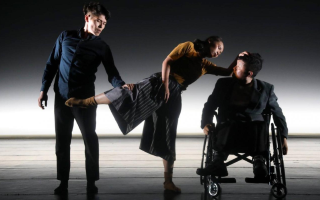The first concert of the new Magnolia Baroque Festival enjoyed a gratifying good turnout but no one – neither the presenters nor I – expected a completely packed, sold-out house for the second, heard June 23 in the Old Salem Visitor Center’s Gray Auditorium.
The enterprising program featured the Tannenberg organ in both solo and accompanying roles. Used to the brighter and more assertive qualities of North German style organs, I was skeptical about its use as a continuo instrument, thinking a chamber organ would be more appropriate. This organ was designed and built by David Tannenberg of Lititz, Pennsylvania, for use in Moravian services, accompanying choirs. It has a warm and mellow tone that readily meshes with a variety of instruments. It is the oldest organ in North Carolina. And it was more than fine – it was wonderful! – in its “assignments” on this occasion.
The composers selected – Heinrich Ignaz Franz Biber (1644-1704), Johann Jacob Froberger (1616-67), Georg Muffat (1653-1707), Johann Pachelbel (1653-1706), and Johann Heinrich Schmelzer (c.1629-89) – are all unjustly neglected and seldom programmed locally. The musicians included organist John O’Brien, violinist Ingrid Matthews, violists Rachel Evans and Alissa Smith, baroque trumpeters Barry Bauguess and Norman Engel, and, plucking the plethora of strings on his theobo, John Lenti. All played restored original instruments or modern copies of old instruments.
Five works featured the organ in solo roles. In sharp contrast to expectations of the form, the Toccata in e minor by Froberger is very quiet and mellow. The norm, opening with a great flourish and full of rhapsodic episodes, was on tap in the Toccata Tertia of Muffat. The reputation of Pachelbel, a victim of overexposure due to bloated transcriptions of his “canon and gigue,” was enhanced by favorable exposure in the form of three fine selections: the stately Fantasia in g minor led directly to an exceptional Toccata in C that featured a long-held cantus firmus supporting a surging musical line, during which selections O’Brien displayed a superb sense of rhythm and crisp articulation. The final Pachelbel piece, Variations on a Chorale, was a late addition to the program. O’Brien wittily introduced the chorale (“Werde munter, mein Gemüte”) and four variations, left incomplete by Pachelbel. It gave the soloist a chance to highlight several of the unusual Tannenberg registrations. The quiet tones of the 8′ Quintadena were featured in the statement of the chorale that came before and followed the variations. The wide range of color that can be conjured up from different 4′ Flauta stops was a highlight of the first and last variations. The most complex assortment of stops were used in the second variation, in which pairs, at least, were engaged for notes on both the upper and lower keyboards.
Several selections by Biber revealed masterworks of the first order, full of originality and flawless craftsmanship. Towering with Bach’s Sonatas and Partitas for solo violin are the 16 far less well-known sonatas that make up Rosenkranz-Sonaten über die 15 Mysterien aus dem Marienleben (Rosary Sonatas about the 15 Mysteries in the life of the Virgin Mary). Biber, perhaps the finest violinist of his era, often makes use of scordatura, the deliberate changing of the tuning of one or more strings of the violin to allow many different combinations of sound that would be impossible on an instrument tuned in the standard way (g-d’-a’-e”).
The “Rosary” Sonata No. 1, in d Minor, for violin and continuo, titled “The Annunciation of the Blessed Mary,” is the only sonata in the series in which the violin is tuned normally. The Prelude and Finale are dominated by virtuoso passages and brilliant figuration. The Aria is a set of variations built on an ostinato first heard played only by the continuo. The violin plays each variation in a different tempo and mood. This was played brilliantly by violinist Ingrid Matthews, supported by the deep bass notes of John Lenti’s theorbo and organist O’Brien. Throughout the festival, Matthews’ intonation was faultless, and her seemingly effortless bowing was a wonder to all. All these qualities were thrown into high relief when she later played Biber’s Passacaglia for solo violin. In decades past, it was not unusual to hear noisy “accidentals,” strange squeaks, and honks that seemed to haunt some early-music string players – along with some mannered choices of phrasing. Matthews’ playing has none of that. Her intonation is immaculate, the artistic liberties she takes are tasteful and well within period style, and in this instance she crafted her interpretation within a view of the work as a whole, not just bar-by-bar or moment-to-moment. I never ceased to be amazed by the elegant, smooth motion of her bowing. It was hard to believe the eyes as she conjured vast quantities of notes in short spans of time in parts of Schmelzer’s Sonata V, for violin, theorbo, and organ. The contrast of a long-repeated ground bass was another notable aspect.
Biber’s compositions also gave us a close-up view of valve-less trumpet virtuosity. One of my favorite CDs is Biber’s Twelve Sonatas (1676) played by The Parley of Instruments, on the Hyperion label. The festival program featured Sonata IV, in C, played by trumpeter Barry Bauguess, violinist Matthews, and violists Evans and Smith, with Lenti on theobo and O’Brien on organ. Bauguess’ precise and seemingly effortless attacks and gem-like trumpet trills were truly breathtaking. The same forces ended the evening brilliantly with Biber’s Sonata X, in g minor, which featured a gorgeous cadence. The instrument and technique were brought into sharper focus by three very short Biber duets for trumpet. Canadian Norman Engel joined Bauguess and they gave a light and humorous history of the two great families of trumpet makers and explained how their reproductions differ from their originals. (The copies have a few small holes that aid them in “focusing” the pitches.) The middle duet, a rarity in a minor key, was pleasantly tart because the notes were not as closely tuned.











